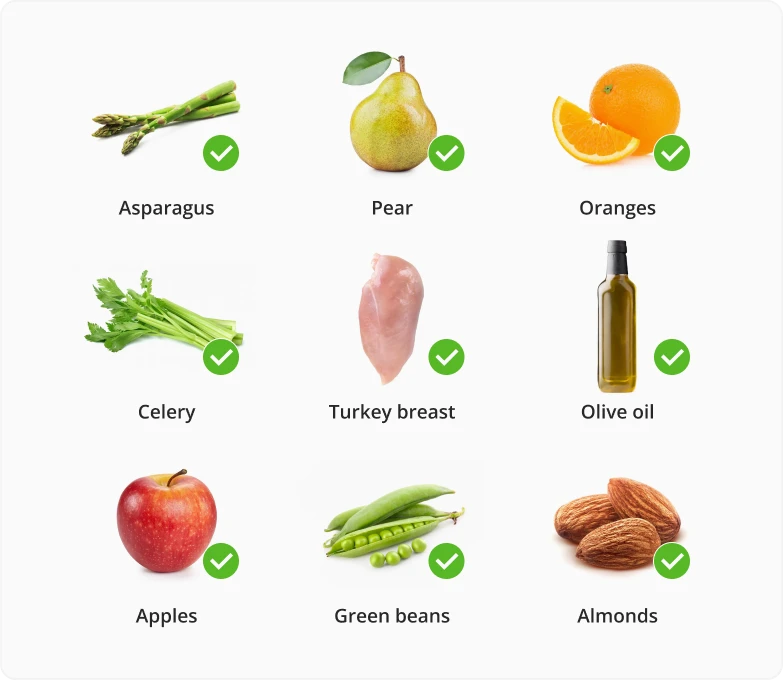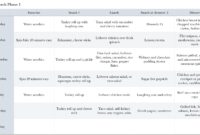South Beach Diet vegetables are a cornerstone of this popular weight-loss plan, offering a delicious and nutritious way to achieve your health goals. This guide delves into the specifics of vegetable selection, preparation, and incorporation into South Beach Diet meals, dispelling common misconceptions and providing practical advice for success. We’ll explore the nutritional benefits of various vegetable types, offering meal plans and recipes to inspire your culinary journey while adhering to the diet’s principles.
Understanding which vegetables are permitted, and how best to prepare and incorporate them into your daily meals is crucial for maximizing the benefits of the South Beach Diet. This guide provides a clear and concise roadmap to help you navigate the world of South Beach Diet-friendly vegetables, empowering you to make informed choices and achieve lasting results.
South Beach Diet Vegetable List
The South Beach Diet emphasizes the consumption of nutrient-rich, low-glycemic vegetables to support weight loss and overall health. This list details vegetables permitted, categorized for clarity and ease of use, along with their nutritional benefits and serving suggestions. Remember to always consult your doctor or a registered dietitian before making significant dietary changes.
South Beach Diet Vegetable Categories and Nutritional Benefits
Vegetables are categorized based on their nutritional profiles and glycemic index. Understanding these categories helps in choosing the best options for a balanced South Beach Diet.
| Vegetable Name | Category | Nutritional Benefits | Serving Suggestions |
|---|---|---|---|
| Spinach | Leafy Greens | Excellent source of Vitamin A, Vitamin K, iron, and antioxidants. Supports eye health, bone health, and immune function. | Add to salads, smoothies, or sauté as a side dish. |
| Kale | Leafy Greens | Rich in Vitamin C, Vitamin K, and fiber. Promotes heart health, boosts immunity, and aids digestion. | Use in salads, soups, or chips. |
| Lettuce (Romaine, Butter, etc.) | Leafy Greens | Good source of Vitamin A, Vitamin K, and folate. Contributes to healthy vision, blood clotting, and cell growth. | Base for salads, wraps, or sandwiches. |
| Broccoli | Cruciferous Vegetables | High in Vitamin C, Vitamin K, and fiber. Possesses anti-cancer properties and supports immune function. | Steam, roast, or add to stir-fries. |
| Cauliflower | Cruciferous Vegetables | Good source of Vitamin C, Vitamin K, and fiber. May help lower cholesterol and improve digestion. | Roast, mash, or rice it as a substitute for potatoes. |
| Brussels Sprouts | Cruciferous Vegetables | Rich in Vitamin C, Vitamin K, and antioxidants. Supports immune function and may help protect against chronic diseases. | Roast, sauté, or add to salads. |
| Carrots | Root Vegetables | Excellent source of Vitamin A (beta-carotene), fiber, and antioxidants. Supports eye health and immune function. | Enjoy raw as a snack, steamed, or roasted. |
| Beets | Root Vegetables | Rich in nitrates, fiber, and antioxidants. May improve blood flow and athletic performance. | Roast, add to salads, or juice. |
| Radishes | Root Vegetables | Good source of Vitamin C and antioxidants. Adds a peppery crunch to salads and other dishes. | Add to salads or enjoy raw with dips. |
| Green Beans | Other Vegetables | Good source of Vitamin K, Vitamin C, and fiber. Supports bone health and immune function. | Steam, roast, or sauté. |
| Asparagus | Other Vegetables | Rich in folate, Vitamin K, and antioxidants. Supports cell growth and may help protect against certain cancers. | Roast, grill, or steam. |
| Bell Peppers (all colors) | Other Vegetables | Good source of Vitamin C and antioxidants. Adds vibrant color and flavor to dishes. | Add to salads, stir-fries, or eat raw. |
Vegetable Preparation Methods for the South Beach Diet
The South Beach Diet emphasizes whole, unprocessed foods, and vegetables are a cornerstone of this eating plan. Proper preparation is key to maximizing their nutritional value and keeping them delicious while adhering to the diet’s guidelines. The following methods showcase ways to prepare vegetables that are both healthy and flavorful.
Roasting Vegetables
Roasting vegetables brings out their natural sweetness and intensifies their flavor. This method is suitable for the South Beach Diet because it requires minimal added fat (a light olive oil coating is sufficient) and preserves many of the vegetables’ nutrients.
- Preheat your oven to 400°F (200°C).
- Chop your chosen vegetables (broccoli, carrots, Brussels sprouts, etc.) into bite-sized pieces.
- Toss the vegetables with a small amount of olive oil, salt, and pepper.
- Spread the vegetables in a single layer on a baking sheet.
- Roast for 20-30 minutes, or until tender and slightly caramelized, flipping halfway through.
Steaming Vegetables
Steaming is a gentle cooking method that retains the most nutrients compared to other cooking methods. It avoids the addition of fats or excessive water, making it ideal for the South Beach Diet.
- Fill a pot with a few inches of water and bring it to a boil.
- Place your chosen vegetables (green beans, asparagus, broccoli florets, etc.) in a steamer basket above the boiling water.
- Cover the pot and steam for 5-10 minutes, or until tender-crisp.
- Season with herbs and spices as desired.
Grilling Vegetables
Grilling adds a smoky char and delicious flavor to vegetables, making them a satisfying side dish or addition to a South Beach-friendly meal. Grilling is suitable provided you use minimal oil and avoid sugary marinades.
- Preheat your grill to medium-high heat.
- Prepare your vegetables (zucchini, bell peppers, onions, etc.) by cutting them into thick slices or chunks.
- Lightly brush the vegetables with olive oil and season with salt, pepper, and herbs.
- Grill for 3-5 minutes per side, or until tender and slightly charred.
Sauteing Vegetables
Sautéing vegetables in a small amount of healthy fat, such as olive oil, allows for quick cooking and the development of rich flavors. This method is appropriate for the South Beach Diet, but portion control and the type of fat used are important.
- Heat a small amount of olive oil in a pan over medium-high heat.
- Add your chosen vegetables (onions, mushrooms, spinach, etc.) and sauté for 5-7 minutes, or until tender-crisp.
- Season with herbs, spices, and a squeeze of lemon juice for added flavor.
Raw Vegetables
Eating vegetables raw is the simplest and quickest preparation method, and it preserves the maximum amount of vitamins and minerals. This is perfectly acceptable for the South Beach Diet, and makes for a great snack or addition to salads.
- Wash your chosen vegetables (carrots, celery, cucumbers, etc.) thoroughly.
- Cut into sticks or slices, as desired.
- Serve with a healthy dip, such as hummus (check ingredients for sugar content) or a simple vinaigrette.
Vegetable Preparation Method Comparison
| Method | Nutritional Value | Ease of Preparation | Advantages | Disadvantages |
|---|---|---|---|---|
| Roasting | High, some nutrient loss | Medium | Enhances flavor, minimal added fat | Requires oven time |
| Steaming | Very High | Easy | Retains maximum nutrients, simple | Can be bland without seasoning |
| Grilling | High | Medium | Adds smoky flavor, visually appealing | Requires grill, potential for burning |
| Sautéing | High | Easy | Quick cooking time, flavorful | Requires careful attention to avoid burning, added fat |
| Raw | Very High | Very Easy | Maximum nutrient retention, no cooking required | May not be suitable for all vegetables |
Incorporating Vegetables into South Beach Diet Meals
Successfully integrating vegetables into your South Beach Diet plan is crucial for maximizing its health benefits. A diverse range of vegetables provides essential vitamins, minerals, and fiber, supporting weight loss and overall well-being while adhering to the diet’s carbohydrate guidelines. This section details how to incorporate various vegetables into your daily meals.
Sample South Beach Diet Meal Plans with Vegetables
The following meal plans demonstrate how to incorporate a variety of vegetables into breakfast, lunch, and dinner while remaining within the South Beach Diet’s carbohydrate guidelines. These examples illustrate the flexibility and deliciousness possible when incorporating vegetables. Remember to adjust portion sizes to meet your individual caloric needs.
Breakfast: Spinach and Mushroom Omelet
- Vegetables Used: Spinach (1 cup), Mushrooms (1/2 cup)
- Preparation Method: Sautéed mushrooms and spinach are added to a 2-egg omelet. A small amount of cheese (e.g., feta or cheddar) can be added for flavor.
- Total Carbohydrate Count (approximate): 5-7 grams
- Benefits: Spinach provides iron and antioxidants, while mushrooms offer B vitamins and selenium. The eggs contribute protein for satiety.
Lunch: Grilled Chicken Salad with Roasted Vegetables
- Vegetables Used: Bell peppers (1/2 cup), Zucchini (1/2 cup), Broccoli florets (1 cup)
- Preparation Method: Vegetables are roasted with olive oil, salt, and pepper. The vegetables are served over a bed of mixed greens with 4 oz grilled chicken breast. A light vinaigrette dressing is used.
- Total Carbohydrate Count (approximate): 10-12 grams
- Benefits: Bell peppers are rich in vitamin C, zucchini provides potassium, and broccoli offers fiber and vitamin K. The chicken provides lean protein.
Dinner: Salmon with Asparagus and Green Beans
- Vegetables Used: Asparagus (1 cup), Green beans (1 cup)
- Preparation Method: Asparagus and green beans are steamed or roasted until tender-crisp. They are served alongside a 4 oz portion of baked or pan-fried salmon.
- Total Carbohydrate Count (approximate): 8-10 grams
- Benefits: Asparagus is a good source of folate, and green beans provide fiber and vitamin A. Salmon provides omega-3 fatty acids and protein.
Vegetable Serving Sizes and Portion Control
Understanding appropriate serving sizes for vegetables is crucial for successful weight management and overall health on the South Beach Diet. While the diet emphasizes non-starchy vegetables, even these should be consumed mindfully to avoid overeating and to ensure balanced nutrition. Portion control helps regulate blood sugar levels, preventing spikes and crashes that can lead to increased hunger and cravings.
Appropriate serving sizes vary depending on the vegetable’s density and your individual caloric needs. Generally, a serving of vegetables is considered to be about one cup of raw, leafy greens or ½ cup of other vegetables, such as broccoli, carrots, or peppers. However, it’s more beneficial to focus on the visual representation of a serving rather than strictly measuring by volume.
Visual Representation of Vegetable Portion Sizes
Imagine a baseball for a serving of leafy greens like spinach or lettuce. A half-cup of chopped vegetables, such as broccoli florets, bell peppers, or carrots, would be roughly the size of your fist. For denser vegetables like corn or peas, a half-cup serving would be about the size of a small orange. Remember that these are estimations; adjust according to your individual needs and hunger levels, always prioritizing non-starchy vegetables. Over-consumption of even healthy vegetables can lead to excess calories.
Importance of Portion Control for Weight Management and Blood Sugar
Portion control plays a vital role in weight management by preventing overconsumption of calories. On the South Beach Diet, where carbohydrate intake is managed, consuming excessive amounts of vegetables, even non-starchy ones, can hinder weight loss progress. Furthermore, controlling portion sizes helps maintain stable blood sugar levels. Large portions of vegetables, while nutritious, can still contribute to a significant carbohydrate load, potentially leading to blood sugar fluctuations. By adhering to appropriate serving sizes, you can better regulate your blood sugar and prevent energy crashes, keeping you feeling satisfied and energized throughout the day. Consider a scenario where someone consumes a large bowl of carrots. While carrots are a healthy vegetable, the sheer volume could lead to a higher-than-ideal carbohydrate intake, potentially impacting blood sugar levels negatively. A more measured approach, sticking to a portion size similar to that of a fist, would be more beneficial.
Common South Beach Diet Vegetable Misconceptions
The South Beach Diet, while emphasizing vegetable consumption, often leads to misunderstandings about which vegetables are suitable and how they should be incorporated. Addressing these misconceptions is crucial for successful weight management and overall health. This section clarifies three prevalent inaccuracies concerning vegetable intake within the South Beach framework.
All Vegetables Are Created Equal
A common misconception is that all vegetables are equally beneficial on the South Beach Diet. This is inaccurate because the diet prioritizes low-glycemic vegetables to minimize blood sugar spikes. While leafy greens, broccoli, and peppers are excellent choices, starchy vegetables like potatoes and corn contain higher glycemic indexes and should be consumed in moderation, particularly during the initial phases of the diet. The glycemic index (GI) is a measure of how quickly a carbohydrate-containing food raises blood glucose levels. High-GI vegetables lead to rapid insulin release, potentially hindering weight loss. Therefore, understanding the GI of different vegetables is essential for effective South Beach Diet adherence.
Unlimited Vegetable Consumption is Always Beneficial
Another misconception is that unlimited vegetable consumption is always beneficial. While vegetables are encouraged, overconsumption of even low-glycemic vegetables can lead to digestive issues and excess calorie intake, potentially hindering weight loss. For instance, consuming large quantities of even healthy vegetables like broccoli could lead to bloating or discomfort. Portion control remains important even with vegetables. The South Beach Diet emphasizes balanced meals, and an over-reliance on vegetables to the exclusion of other food groups (lean protein, healthy fats) can be detrimental to overall nutritional balance.
Vegetable Preparation Doesn’t Matter
Finally, many believe that the method of vegetable preparation is irrelevant. This is false. Cooking methods can significantly alter a vegetable’s glycemic index. For example, boiled potatoes have a higher GI than roasted potatoes. Similarly, pureeing vegetables can increase their GI. Therefore, choosing appropriate cooking methods, such as steaming, grilling, or roasting, helps to maintain a lower glycemic load and maximize the benefits of vegetables within the South Beach Diet.
Importance of Personalized Dietary Advice
It’s crucial to remember that dietary needs vary significantly based on individual factors such as age, activity level, underlying health conditions, and personal preferences. While general guidelines exist, the South Beach Diet, like any other dietary approach, benefits from personalized guidance. Consulting a registered dietitian or healthcare professional ensures a tailored plan that addresses specific needs and promotes optimal health outcomes. They can provide accurate information, address individual concerns, and help navigate potential challenges to ensure a safe and effective approach to weight management.
Recipes Featuring South Beach Diet Vegetables
South Beach Diet emphasizes the importance of incorporating plenty of non-starchy vegetables into your meals. These recipes showcase delicious and satisfying ways to do just that, while adhering to the diet’s principles of limiting refined carbohydrates and unhealthy fats. Each recipe is designed to be both flavorful and nutritious, providing a balanced intake of vitamins, minerals, and fiber.
Roasted Mediterranean Vegetables with Lemon-Herb Dressing
This recipe highlights the vibrant flavors of Mediterranean vegetables, roasted to perfection and tossed in a light and zesty dressing. It’s a perfect side dish or a light meal on its own.
Ingredients:
- 1 medium zucchini, chopped
- 1 medium yellow squash, chopped
- 1 red bell pepper, chopped
- 1 cup cherry tomatoes
- 1/2 red onion, chopped
- 2 cloves garlic, minced
- 2 tablespoons olive oil
- 1 tablespoon lemon juice
- 1 teaspoon dried oregano
- 1/2 teaspoon dried basil
- Salt and pepper to taste
Instructions:
- Preheat oven to 400°F (200°C).
- In a large bowl, combine zucchini, yellow squash, bell pepper, cherry tomatoes, red onion, and garlic.
- Drizzle with olive oil and toss to coat.
- Season with oregano, basil, salt, and pepper.
- Spread vegetables in a single layer on a baking sheet.
- Roast for 20-25 minutes, or until vegetables are tender and slightly browned.
- While vegetables are roasting, whisk together lemon juice and remaining olive oil in a small bowl.
- Once vegetables are cooked, toss with lemon-herb dressing.
Nutritional Information (per serving, approximate):
Calories: 150-200; Fat: 10-15g; Protein: 3-5g; Carbohydrates: 10-15g; Fiber: 5-7g
Shrimp Scampi with Asparagus and Zucchini Noodles
This low-carb twist on classic shrimp scampi uses zucchini noodles instead of pasta, creating a lighter and more vegetable-rich dish.
Ingredients:
- 1 pound shrimp, peeled and deveined
- 1 pound asparagus, trimmed and cut into 1-inch pieces
- 2 medium zucchini, spiralized into noodles
- 2 cloves garlic, minced
- 2 tablespoons olive oil
- 1/4 cup dry white wine (optional)
- 2 tablespoons lemon juice
- 1 tablespoon chopped fresh parsley
- Salt and pepper to taste
Instructions:
- Heat olive oil in a large skillet over medium heat.
- Add garlic and cook for 1 minute, until fragrant.
- Add shrimp and asparagus and cook for 3-4 minutes per side, until shrimp is pink and asparagus is tender-crisp.
- If using, add white wine and cook for 1 minute, until slightly reduced.
- Stir in zucchini noodles, lemon juice, and parsley.
- Cook for 1-2 minutes, until zucchini noodles are heated through.
- Season with salt and pepper to taste.
Nutritional Information (per serving, approximate):
Calories: 250-300; Fat: 15-20g; Protein: 25-30g; Carbohydrates: 10-15g; Fiber: 4-6g
Stuffed Bell Peppers with Ground Turkey and Vegetables
This recipe offers a satisfying and nutritious meal packed with vegetables and lean protein.
Ingredients:
- 4 large bell peppers (various colors), halved and seeded
- 1 pound ground turkey
- 1 onion, chopped
- 1 cup chopped mushrooms
- 1 cup chopped broccoli florets
- 1/2 cup chopped carrots
- 1 (14.5 ounce) can diced tomatoes, undrained
- 1 teaspoon dried oregano
- 1/2 teaspoon garlic powder
- Salt and pepper to taste
Instructions:
- Preheat oven to 375°F (190°C).
- In a large skillet, brown ground turkey over medium heat. Drain off any excess fat.
- Add onion, mushrooms, broccoli, and carrots to the skillet and cook until softened, about 5-7 minutes.
- Stir in diced tomatoes, oregano, garlic powder, salt, and pepper.
- Spoon turkey mixture into bell pepper halves.
- Place stuffed peppers in a baking dish and bake for 30-40 minutes, or until peppers are tender and filling is heated through.
Nutritional Information (per serving, approximate):
Calories: 300-350; Fat: 15-20g; Protein: 30-35g; Carbohydrates: 20-25g; Fiber: 6-8g
Tips for Adapting Recipes:
- Substitute vegetables: Feel free to swap out vegetables based on your preferences and what’s in season. For example, substitute spinach for asparagus, or cauliflower for broccoli.
- Adjust seasonings: Experiment with different herbs and spices to create your own unique flavor combinations.
- Add protein: Increase the protein content by adding more shrimp, chicken, fish, or beans to any of these recipes.
- Control portion sizes: Be mindful of your portion sizes to maintain a healthy calorie intake.
- Dietary restrictions: Adapt recipes to accommodate specific dietary needs, such as gluten-free or dairy-free options. For example, use gluten-free bread crumbs or dairy-free cheese alternatives.
Summary
Successfully navigating the South Beach Diet requires a balanced approach, and vegetables play a vital role. By understanding the permitted vegetables, optimal preparation methods, and appropriate portion sizes, you can create satisfying and nutritious meals that support your weight-loss goals and overall well-being. Remember to consult with a healthcare professional for personalized dietary advice tailored to your individual needs and health conditions. Embrace the versatility of vegetables and enjoy the journey to a healthier you!




